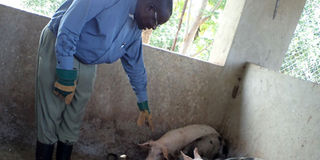Catholic priest took up pig farming to become self-reliant

Msgr Dr Cosmas Alule at his piggery at Alokolum seminary. PHOTO BY ALICE ADIKIN
What you need to know:
- Monsignor Dr Cosmas Alule does not believe in handouts and that is he started a piggery at his workplace, writes Alice Adikin
When Monsignor (Msgr) Dr. Cosmas Alule was posted to Uganda National Major Seminary Alokolum in Gulu District as a rector, his goal was to ensure self-sustainability of the institution. A post he got in 2007, Msgr Alule says he did not want the seminary to continue depending on donations since the institution had potential to generate its own income. After brainstorming with staff, the staff engages in income generating projects such as bakery, restaurant, poultry and piggery to enhance the financial muscle. They decided start off with a piggery. Dr Alule says the seminary that started in 1973 had piggery but due to civil unrest, it was abandoned.
Starting out
Unlike new farmers, Dr Alule already had pig sties that just needed retouching. The improved sties were partitioned into 16 compartments. He says they bought seven cross breed piglets of one-month-old (five female and two male) at Shs50,000 each. These multiplied and the number increased to 87, unfortunately all these died when swine fever hit the region. Dr Alule says the loss was a major setback but they stuck to the advice of the veterinary doctor who recommended disinfection. “He told us to disinfect the sties and leave them free for three months, but we decided to leave it for six months,” explains Dr Alule.
The following year (2008), they got seven cross breed piglets, (five females and two males) which they received as donations from Christians and from their sister seminary in Gaba.
He says they got piglets from different sources because crossbreeding gives best results. And they surely did. Since then, they have been selling off pigs.
He says the loss taught them a lesson that they should not keep many pigs. They have more than 50 pigs, including piglets. As a way of managing numbers, the female ones that have littered a number of times are sold off.
Feeding
Dr Alule says their pigs feed on fish meal mixed with rice husk, maize bran, and sun flower cake and food leftovers. He estimated feed consumption of very adult pig to 4kgs a day, 2kgs for piglets during holidays when there are no left overs, and 1.5kg a day for an adult,1/2kg for piglets during school days. Alule says they spend Shs200,000 on feeds per week during holidays. And Shs100,000 when its school time.
He says, “Experience has taught me that when the pigs start eating soil, it is a lack of salt nutrients in their diets.”
Maintenance
The sties are cleaned every day and all the leftovers are thrown because like human beings when food is left there the animals can eat all the time.
They have also dug and cemented a large water pool and put a standby water tap with long pipe to fill the pool where pigs can wash and clean themselves.
“We always open them in shifts according to their age group to go out and also go to the pool area to cool,” he says. The sties are fenced off to minimise interaction with birds and stray animals. “Fencing also helps animals to gain weight in a short time,” Alule says. To minimise chances of infections, only four people (two students and two workers) have been assigned to take care of the piggery.
For walk-in clients, there is disinfectant on the farm before accessing the piggery. The piggery has two fulltime workers who are paid between Shs90,000 and Shs150,000 per month.
Market
Dr. Alule says their pigs are on high demand and some clients book for piglets. At least three sows litter every month and each not less than 10 piglets. One month old piglets are sold at Shs50,000. An adult pig is sold between Shs700,000 and Shs1m depending on their weight. After deducting all costs, Fr Alule says he makes at least Shs4m as profit every season. There are three seasons every year.
He says their consistent client is government through its agricultural programmes such as Naads and OWC.
Their second market is the seminary itself because they have more than 300 consumers of pork which requires them to slaughter about two pigs every week for every person to be served enough.
“The seminary expenses are paid by the Uganda Episcopal Conference,” he says. There are also individual farmers who buy piglets for restocking as well as butcheries.
Achievements
Dr Alule says this project has enabled him to run the seminary without waiting for donations.
“With our other income generating activities, the seminary is self-reliant and we stopped getting donations from West,” he shares.
The piggery also serves as the training centre for students and farmers such as Gulu Farmers Association who go to learn about modern piggeries.
Challenges
Their major challenge is power fluctuation, because their water pump is electric generated. Power fluctuation affects their means of getting clean water for their animals.
Feeding cost is expensive, especially when the animal population goes beyond 50.
The fear of the outbreak of African swine fever is a big threat that has forced Dr Alule to keep few pigs. He says this has affected them because sometimes they fail to meet client demands.
Plans
Dr Alule says he wants to expand the piggery to tap into the market in South Sudan. He also says they intend to venture in commercial poultry.
Did you know
China is the world’s largest producer and consumer of pork. Pork has long been important in the Chinese diet. It makes up to 60per cent of China’s total meat consumption. With population growth, rapid economic development, continuous urbanisation and an expanding middle class, China’s total pork consumption has increased fivefold since 1980.




